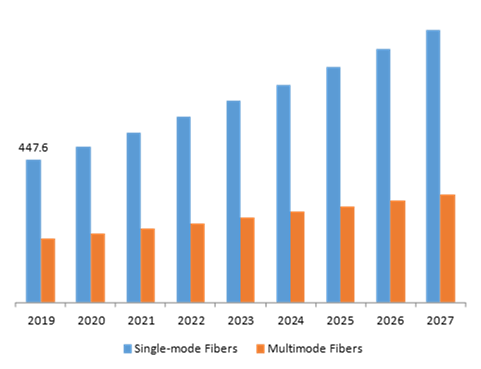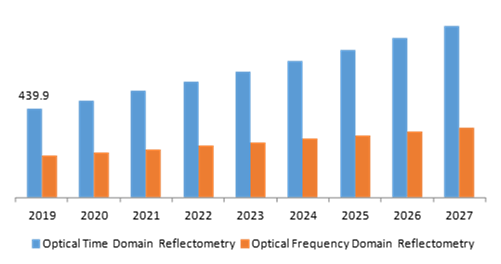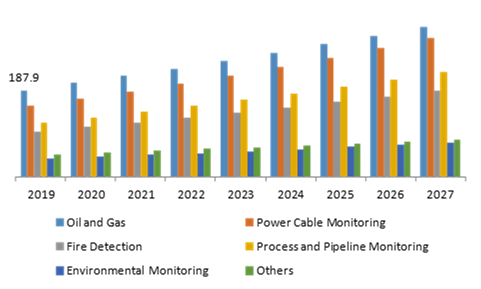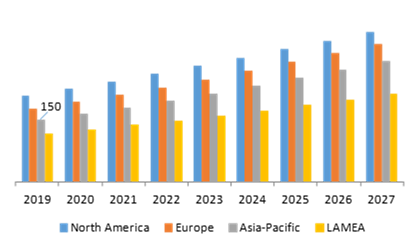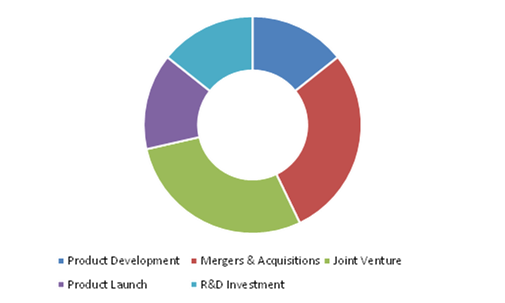Distributed Temperature Sensing Market Report
RA00407
Distributed Temperature Sensing Market, by Fiber Type (Single-Mode Fiber, Multimode Fiber), Operating Principle (OTDR, OFDR), Application (Oil & Gas Production, Power Cable Monitoring, Process and Pipeline Monitoring, Fire Detection, Environmental Monitoring), Regional Analysis (North America, Europe, Asia-Pacific, LAMEA): Global Opportunity Analysis and Industry Forecast, 2020–2027
The global distributed temperature sensing market forecasts a revenue generation of $1,196.5 million by 2027, rising from $648.3 million in 2019 at a healthy growth rate of 7.8%. Asia-Pacific distributed temperature sensing market is expected to grow at a CAGR of 8.5% by registering a revenue of $290.7 million, during the forecast period. Extensively increasing industries coupled with the presence of market players and their heavy investment in innovations are anticipated to accelerate the growth of the Asia-Pacific market.
Distributed Temperature Sensing Market Analysis:
Distributed temperature sensing (DTS) is an optoelectronic technology that measures temperature over the length of the optical fiber cable at any time utilizing the fiber itself as the sensing element. The significant feature of a DTS system is that it offers a continuous (or distributed) temperature measurement along the length of the cable.
Impact Analysis of COVID-19 on the Distributed Temperature Sensing Market
The viral infection of the coronavirus disease (COVID-19) has dramatically affected a wide range of sectors such as food and beverages, retail, semiconductors, and automotive. The business and industrial processes across regions have been massively disrupted due to the outbreak of the COVID-19 pandemic. It is predicted that demand for DTS technologies will rise after the chaos of pandemic settles; this is mainly because of the product innovations during the COVID-19 pandemic period. For example, in March 2020, Sumitomo Electric Industries, Ltd., a leading manufacturer of electric wires and optical fibers, made an announcement to launch its OPTHERMO FTS3500 fiber-optic distributed temperature sensing system. FTS3500 system has a long-life and durable optical fibers along with the capability to monitor wide-range, long-distance temperature distribution. Moreover, the system is built with lightweight and narrow sensors that offer excellent workability. These continuous product developments and effective strategy implementations may provide lucrative investment opportunities for the global DTS market, throughout the pandemic timeframe.
Promising Safety & reliability of DTS systems for monitoring applications may drive the market
The growth of the global DTS market is mainly driven by its low operational expenses. Moreover, the DTS systems are safe for use in hazardous zones such as those bearing explosive gas atmosphere and others; therefore, such sensors are ideal for use in industrial sensing applications. These factors may lead to driving the demand for DTS systems, which may eventually increase the growth of the global market during the projected period. In addition, various market players are following effective strategies such as technological development and product launch to strengthen their footprint in the global market. For example, in November 2018, ABB, a pioneering technology leader in electrification products, announced the launch of non-invasive, highly accurate temperature sensing systems. This new temperature sensor utilizes innovative technology with proven components along with having great significance in the oil & gas, food & beverage, and chemical industries. The above-stated factors may drive the growth of the global DTS market during the review period.
To know more about distributed temperature sensing market drivers, get in touch with our analysts here.
The high costs of DTS solutions are projected to obstruct the global DTS industry growth
The higher initial expenses associated with the DTS technologies are expected to decrease the growth of the global market over the projected period. In addition, complexities in fault detection and troubleshooting processes are also anticipated to decline the demand for DTS systems, which may eventually restrain the global market growth during the analysis timeframe.
The key role of DTS systems in hydrogeological research to generate vast opportunities in the Global DTS in the global marketplace
DTS technologies play a key role in the monitoring of downhole temperature to hydrogeological study at unprecedentedly high frequency. The DTS has been majorly applied in the subsurface thermal property estimation, site investigations of groundwater flow, and in the well flow. In addition, DTS systems are significantly used to perform heat pulse tests, thermal advection tests, and hybrid cable flow logging. The application of DTS has huge importance over discrete point temperature measurements, mainly in deep wells, along with the potential for method developments in conjunction with other hydrogeophysical investigations. These factors may lead to generate huge investment opportunities in the global market, in the future years.
To know more about distributed temperature sensing Market Opportunities, get in touch with our analysts here.
Distributed Temperature Sensing Market, by Fiber Type:
The single-mode fiber type shall have significant market growth and it shall register a revenue of $855.9 million by 2027, increasing at a CAGR of 8.3%.
Source: Research Dive Analysis
The single-mode fiber type for a global distributed temperature sensing market shall have an exponential growth in the global market and it is expected to surpass $855.9 million by 2027, rising from $447.6 million in 2019. The single-mode fiber temperature sensing systems are highly significant over conventional sensors due to their ability to monitor temperature across large surfaces, like a submarine or underground areas. In addition, this advanced sensing system allows measurements at high temperatures coupled and can withstand in hydrogen-based darkening effects. The multi-mode fiber type for the global market is estimated to generate a revenue of $340.6 million, throughout the forecast period. The multi-mode fiber temperature sensing system is recognized as an ideal solution because this system is highly preferable for medium to long-range (5-30 km) industrial monitoring applications. Also, these sensing systems are highly reliable, safe, and user friendly.
Distributed Temperature Sensing Market, by Operating Principle:
The OTDR based system shall have rapid growth in the global market; this is mainly because these systems are cost-effective and easy-to-use.
Source: Research Dive Analysis
The OTDR sub-segment for the global market will have a substantial growth and it is expected to surpass $851.2 million during the analysis period. In the OTDR (Optical Time Domain Reflectometry) principle, a laser pulse is generated from semiconductor lasers and sent into the fiber. The backscattering of light is primarily analyzed for monitoring of temperature. Therefore, the OTDR principle is significantly utilized for measuring the losses in the telecom sector. This factor may further drive the growth of this sub-segment over the forecast period. Contrary to this, the OFDR sub-segment for the global distributed temperature sensing market is anticipated to generate a revenue of $345.3 million, during the forecast period due to its high refresh rate along with significant spatial resolution.
Distributed Temperature Sensing Market, by Application:
The oil & gas production industries for the distributed temperature sensing shall have rapid growth in the global market.
Source: Research Dive Analysis
The oil and gas production sub-segment will have a significant market share and is expected to reach upto $325.4 million during the forecast period. Distributed optic sensing technologies play a crucial role in providing important information at all points with the wellbore to enhance the efficiency and integrity of wells. DTS systems provide a complete temperature profile to understand the integrity of casing, tubing, and completion components. These factors are expected to increase the demand for temperature sensing systems, which may further be predicted to fuel the market growth over the projected period. On the other hand, the power cable monitoring application will be a rapidly growing sub-segment during the projected period and is estimated to register a revenue of $301.0 million by 2027. DTS technologies are mainly used for the improvement of the intelligent cable monitoring system for underground electricity distribution systems. Moreover, the rising use of smart grids along with real-time innnovations for underground distribution power cables are also projected to provide growth opportunities for the global distributed temperatue sensing market in the projected timeframe.
Regional Insights:
The Asia-Pacific market has witnessed substantial growth in the global market, and it will reach up to $290.7 million by the end of 2027, increasing at a growth rate of 8.5%.
Source: Research Dive Analysis
Asia-Pacific distributed temperature sensing market has a rapid growth in the market. It has registered a revenue of $150.0 million in 2019 and it is expected to grow at a healthy CAGR of 8.5%, generating a revenue of $290.7 million during the forecast period. An increasing need for industrial safety measures coupled with a massive expansion of the Asian industrial sector is estimated to bolster the distributed temperature sensing market growth, in the coming years. Moreover, the massive expansion of a network of power transmission cables in Asian economies is anticipated to fuel the demand for distributed temperature sensing in APAC over the forecast period. For instance, according to the global transmission report, the energy demand in Asia is projected to rise by 2.4% annually over the next 20 years, particularly in East Asia and South Asia region. Such factors are anticipated to increase the adoption of DTS systems in the Asian market during the analysis period. However, North America distributed temperature sensing market had a dominating share in the global market. It generated a revenue of $206.2 million in 2019 and it is expected to generate a revenue of $361.3 million during the forecast period. The presence of leading manufacturers such as Halliburton and Honeywell has made this region a considerable market for distributed temperature sensing.
Competitive Scenario in the Global Distributed Temperature Sensing Market:
Advanced product development coupled with mergers & acquisitions are the frequent strategies followed by significant market players
Source: Research Dive Analysis
Leading distributed temperature sensing market players are NXP Semiconductors., Stmicroelectronics n.v., Qualcomm Technologies, Inc., Infineon Technologies AG, Texas Instruments Incorporated., Sony Corporation, Atmel Corporation (Microchip Technology Inc.), Johnson Controls., Robert Bosch GmbH, and Honeywell International Inc.
Distributed temperature sensing global leaders are concentrating highly on strategic tie-ups, advanced product developments, and other effective strategies.
Porter’s Five Forces Analysis for Distributed Temperature Sensing Market:
- Bargaining Power of Suppliers: The bargaining power of the suppliers is less owing to the cut-throat competition. Furthermore, the concentration of suppliers is high as compared to companies operating in the DTS technologies. Therefore, suppliers will have LOW bargaining power.
- Bargaining Power of Buyers: The companies operating in the global distributed temperature sensing market is low. Thus, the negotiation power of buyers ultimately falls. Therefore, the bargaining power of buyers is LOW
- Threat of New Entrants: Emerging companies operating in the market are following various strategies such as technological advancements, product development, and strategic tie-ups. In addition to this, supportive policies of governmental bodies for DTS technologies are also offering support to the startups. Therefore, the threat of new entrants is HIGH
- Threat of Substitutes: There is no alternative for this market so far. Thus, the threat from substitutes of the distributed temperature sensing system is LOW.
- Competitive Rivalry in the Market: Industry players of the market are implementing the different strategies to gain a prominent position in the global market. These companies are focusing significantly on the capacity of expansion, product promotion, and many others. Furthermore, the presence of top distributed temperature sensing solution providers such as Honeywell, NXP Semiconductors, and Infineon Technologies AG is also influencing the global market. Therefore, the competitive rivalry among the competitors is HIGH.
| Aspect | Particulars |
| Historical Market Estimations | 2018-2019 |
| Base Year for Market Estimation | 2019 |
| Forecast timeline for Market Projection | 2019-2027 |
| Geographical Scope | North America, Europe, Asia-Pacific, LAMEA |
| Segmentation by Fiber type |
|
| Segmentation by Operating Principle |
|
| Segmentation by Application |
|
| Key Countries Covered | U.S., Canada, Mexico, Germany, France, UK, Italy, Spain, Russia, Rest of Europe, China, Japan, India, Australia, South Korea, Rest of Asia-Pacific, Brazil, Saudi Arabia, United Arab Emirates, Rest of LAMEA |
| Key Companies Profiled |
|
Q1. What is the size of the distributed temperature sensing market?
A. The global distributed temperature sensing market size was over $648.3 million in 2019 and is projected to reach $1,196.5 million by 2027.
Q2. Which are the major companies in the distributed temperature sensing Market?
A. NXP Semiconductors., Stmicroelectronics n.v., and Qualcomm Technologies, Inc. are some of the key players in the global distributed temperature sensing market.
Q3. Which region possesses greater investment opportunities in the coming future?
A. The Asia-Pacific region possesses great investment opportunities for investors to witness the most promising growth in the future.
Q4. What is the growth rate of the Asia-Pacific market?
A. The Asia Pacific distributed temperature sensing market is anticipated to grow at 8.5% CAGR during the forecast period.
Q5. What are the strategies opted by the leading players in this market?
A. Technological advancements, product development, along with joint ventures are the key strategies opted by the operating companies in this market.
Q6. Which companies are investing more in R&D practices?
A. Infineon Technologies AG, Texas Instruments Incorporated. are investing more in R&D activities for developing new products and technologies.
1. Research Methodology
1.1. Desk Research
1.2. Real-time insights and validation
1.3. Forecast model
1.4. Assumptions and forecast parameters
1.4.1. Assumptions
1.4.2. Forecast parameters
1.5. Data sources
1.5.1. Primary
1.5.2. Secondary
2. Executive Summary
2.1. 360° summary
2.2. By Fuel Type Trends
2.3. By Fiber Type Trends
2.4. By Operating Principle Trends
2.5. By Application Trends
3. Market overview
3.1. Market segmentation & definitions
3.2. Key takeaways
3.2.1. Top investment pockets
3.2.2. Top winning strategies
3.3. Porter’s five forces analysis
3.3.1. Bargaining power of consumers
3.3.2. Bargaining power of suppliers
3.3.3. Threat of new entrants
3.3.4. Threat of substitutes
3.3.5. Competitive rivalry in the market
3.4. Market dynamics
3.4.1. Drivers
3.4.2. Restraints
3.4.3. Opportunities
3.5. Technology landscape
3.6. Regulatory landscape
3.7. Patent landscape
3.8. Pricing overview
3.8.1. By Fiber Type
3.8.2. By Operating Principle
3.8.3. By Application
3.9. Market value chain analysis
3.10. Strategic overview
4. Distributed temperature sensing Market, by Fiber Type
4.1. Single-Mode Fiber
4.1.1. Market size and forecast, by region, 2018-2026
4.1.2. Comparative market share analysis, 2019 & 2027
4.2. Multimode Fiber
4.2.1. Market size and forecast, by region, 2018-2026
4.2.2. Comparative market share analysis, 2019 & 2027
5. Distributed temperature sensing Market, by Operating Principle
5.1. OTDR
5.1.1. Market size and forecast, by region, 2018-2026
5.1.2. Comparative market share analysis, 2019 & 2027
5.2. OFDR
5.2.1. Market size and forecast, by region, 2018-2026
5.2.2. Comparative market share analysis, 2019 & 2027
6. Distributed temperature sensing Market, by Application
6.1. Oil & Gas Production
6.2. Power Cable Monitoring
6.3. Pipeline Surveillance
6.4. Fire Detection
6.5. Environmental Monitoring
7. Distributed temperature sensing Market, by region
7.1. North America
7.1.1. Market size and forecast, by fiber type, 2019-2027
7.1.2. Market size and forecast, by operating principle, 2019-2027
7.1.3. Market size and forecast, by application, 2019-2027
7.1.4. Market size and forecast, by country, 2019-2027
7.1.5. Comparative market share analysis, 2019 & 2027
7.1.6. U.S.
7.1.6.1. Market size and forecast, by fiber type, 2019-2027
7.1.6.2. Market size and forecast, by operating principle, 2019-2027
7.1.6.3. Market size and forecast, by application, 2019-2027
7.1.6.4. Comparative market share analysis, 2019 & 2027
7.1.7. Canada
7.1.7.1. Market size and forecast, by fiber type, 2019-2027
7.1.7.2. Market size and forecast, by operating principle, 2019-2027
7.1.7.3. Market size and forecast, by application, 2019-2027
7.1.7.4. Comparative market share analysis, 2019 & 2027
7.1.8. Mexico
7.1.8.1. Market size and forecast, by fiber type, 2019-2027
7.1.8.2. Market size and forecast, by operating principle, 2019-2027
7.1.8.3. Market size and forecast, by application, 2019-2027
7.1.8.4. Comparative market share analysis, 2019 & 2027
7.2. Europe
7.2.1. Market size and forecast, by fiber type, 2019-2027
7.2.2. Market size and forecast, by operating principle, 2019-2027
7.2.3. Market size and forecast, by application, 2019-2027
7.2.4. Market size and forecast, by country, 2019-2027
7.2.5. Comparative market share analysis, 2019 & 2027
7.2.6. Germany
7.2.6.1. Market size and forecast, by fiber type, 2019-2027
7.2.6.2. Market size and forecast, by operating principle, 2019-2027
7.2.6.3. Market size and forecast, by application, 2019-2027
7.2.6.4. Comparative market share analysis, 2019 & 2027
7.2.7. UK
7.2.7.1. Market size and forecast, by fiber type, 2019-2027
7.2.7.2. Market size and forecast, by operating principle, 2019-2027
7.2.7.3. Market size and forecast, by application, 2019-2027
7.2.7.4. Comparative market share analysis, 2019 & 2027
7.2.8. France
7.2.8.1. Market size and forecast, by fiber type, 2019-2027
7.2.8.2. Market size and forecast, by operating principle, 2019-2027
7.2.8.3. Market size and forecast, by application, 2019-2027
7.2.8.4. Comparative market share analysis, 2019 & 2027
7.2.9. Spain
7.2.9.1. Market size and forecast, by fiber type, 2019-2027
7.2.9.2. Market size and forecast, by operating principle, 2019-2027
7.2.9.3. Market size and forecast, by application, 2019-2027
7.2.9.4. Comparative market share analysis, 2019 & 2027
7.2.10. Italy
7.2.10.1. Market size and forecast, by fiber type, 2019-2027
7.2.10.2. Market size and forecast, by operating principle, 2019-2027
7.2.10.3. Market size and forecast, by application, 2019-2027
7.2.10.4. Comparative market share analysis, 2019 & 2027
7.2.11. Rest of Europe
7.2.11.1. Market size and forecast, by fiber type, 2019-2027
7.2.11.2. Market size and forecast, by operating principle, 2019-2027
7.2.11.3. Market size and forecast, by application, 2019-2027
7.2.11.4. Comparative market share analysis, 2019 & 2027
7.3. Asia Pacific
7.3.1. Market size and forecast, by fiber type, 2019-2027
7.3.2. Market size and forecast, by operating principle, 2019-2027
7.3.3. Market size and forecast, by application, 2019-2027
7.3.4. Market size and forecast, by country, 2019-2027
7.3.5. Comparative market share analysis, 2019 & 2027
7.3.6. China
7.3.6.1. Market size and forecast, by fiber type, 2019-2027
7.3.6.2. Market size and forecast, by operating principle, 2019-2027
7.3.6.3. Market size and forecast, by application, 2019-2027
7.3.6.4. Comparative market share analysis, 2019 & 2027
7.3.7. India
7.3.7.1. Market size and forecast, by fiber type, 2019-2027
7.3.7.2. Market size and forecast, by operating principle, 2019-2027
7.3.7.3. Market size and forecast, by application, 2019-2027
7.3.7.4. Comparative market share analysis, 2019 & 2027
7.3.8. Australia
7.3.8.1. Market size and forecast, by fiber type, 2019-2027
7.3.8.2. Market size and forecast, by operating principle, 2019-2027
7.3.8.3. Market size and forecast, by application, 2019-2027
7.3.8.4. Comparative market share analysis, 2019 & 2027
7.3.9. Rest of Asia Pacific
7.3.9.1. Market size and forecast, by fiber type, 2019-2027
7.3.9.2. Market size and forecast, by operating principle, 2019-2027
7.3.9.3. Market size and forecast, by application, 2019-2027
7.3.9.4. Comparative market share analysis, 2019 & 2027
7.4. LAMEA
7.4.1. Market size and forecast, by fiber type, 2019-2027
7.4.2. Market size and forecast, by operating principle, 2019-2027
7.4.3. Market size and forecast, by application, 2019-2027
7.4.4. Market size and forecast, by country, 2019-2027
7.4.5. Comparative market share analysis, 2019 & 2027
7.4.6. Latin America
7.4.6.1. Market size and forecast, by fiber type, 2019-2027
7.4.6.2. Market size and forecast, by operating principle, 2019-2027
7.4.6.3. Market size and forecast, by application, 2019-2027
7.4.6.4. Comparative market share analysis, 2019 & 2027
7.4.7. Middle East
7.4.7.1. Market size and forecast, by fiber type, 2019-2027
7.4.7.2. Market size and forecast, by operating principle, 2019-2027
7.4.7.3. Market size and forecast, by application, 2019-2027
7.4.7.4. Comparative market share analysis, 2019 & 2027
7.4.8. Africa
7.4.8.1. Market size and forecast, by fiber type, 2019-2027
7.4.8.2. Market size and forecast, by operating principle, 2019-2027
7.4.8.3. Market size and forecast, by application, 2019-2027
7.4.8.4. Comparative market share analysis, 2019 & 2027
8. Company profiles
8.1. Stmicroelectronics n.v.
8.1.1. Business overview
8.1.2. Financial performance
8.1.3. Product portfolio
8.1.4. Recent strategic moves & developments
8.1.5. SWOT analysis
8.2. NXP Semiconductors.
8.2.1. Business overview
8.2.2. Financial performance
8.2.3. Product portfolio
8.2.4. Recent strategic moves & developments
8.2.5. SWOT analysis
8.3. Infineon Technologies AG
8.3.1. Business overview
8.3.2. Financial performance
8.3.3. Product portfolio
8.3.4. Recent strategic moves & developments
8.3.5. SWOT analysis
8.4. Qualcomm Technologies, Inc.
8.4.1. Business overview
8.4.2. Financial performance
8.4.3. Product portfolio
8.4.4. Recent strategic moves & developments
8.4.5. SWOT analysis
8.5. Atmel Corporation (Microchip Technology Inc.)
8.5.1. Business overview
8.5.2. Financial performance
8.5.3. Product portfolio
8.5.4. Recent strategic moves & developments
8.5.5. SWOT analysis
8.6. Texas Instruments Incorporated.
8.6.1. Business overview
8.6.2. Financial performance
8.6.3. Product portfolio
8.6.4. Recent strategic moves & developments
8.6.5. SWOT analysis
8.7. Robert Bosch GmbH
8.7.1. Business overview
8.7.2. Financial performance
8.7.3. Product portfolio
8.7.4. Recent strategic moves & developments
8.7.5. SWOT analysis
8.8. Johnson Controls.
8.8.1. Business overview
8.8.2. Financial performance
8.8.3. Product portfolio
8.8.4. Recent strategic moves & developments
8.8.5. SWOT analysis
8.9. Sony Corporation
8.9.1. Business overview
8.9.2. Financial performance
8.9.3. Product portfolio
8.9.4. Recent strategic moves & developments
8.9.5. SWOT analysis
8.10. Honeywell International Inc.
8.10.1. Business overview
8.10.2. Financial performance
8.10.3. Product portfolio
8.10.4. Recent strategic moves & developments
8.10.5. SWOT analysis
Analyst Review:
Distributed temperature sensing or DTS is an optoelectronic technology that measure temperatures at any time by means of optical fiber cables using the fiber itself as the element for sensing. DTS systems are majorly developed for the oil and gas industry to help reservoir engineers in improving the monitoring techniques. Temperatures are recorded alongside the optical sensor cable, consequently mapping it as a continuous profile & not at points. The temperature profiles are monitored at surface in real-time, reducing the need for production logs, decreasing well interventions, averting deferred production losses, and minimizing operating costs.
Impact of COVID-19 on the DTS Industry
The global distributed temperature sensing market is projected to be massively affected due to the outbreak of COVID-19 across the globe owing to the disruption in the business and industrial processes. However, the key industry players of the market are focusing on product innovations to sustain in the pandemic crisis. For instance, in March 2020, a leading manufacturer of optical fibers and electric wires, Sumitomo Electric Industries, announced the launch of ‘OPTHERMO FTS3500,’ which is fiber-optic DTS system. FTS3500 system has a long-life & durable optical fibers and also has the capability to monitor long distance, wide-ranging temperature distribution.
These effective strategy implementations and continuous product developments by the key industry players is estimated provide massive investment opportunities in the global DTS market, all through the pandemic period.
Key Developments in the Global Market
The major industry players are implementing numerous growth strategies such as technological advancements, product developments, and business expansion to obtain a strong position in the overall market, which is subsequently supporting the DTS market to grow at a rapid pace in the forecast period.
For instance, in February 2019, the Japan-based developer of advanced test & measurement instruments, Yokogawa Test & Measurement Corporation introduced the AQ1210 OTDR (optical time domain reflectometer), which is a successor to the AQ1200 OTDR and has been enhanced with the addition of larger capacity battery and touchscreen functionality. It is ideal for use in the maintenance and installation of fiber-optic cables.
In November 2019, AP Sensing entered into a collaboration with a Danish Transmission Operator, Energinet for offering Kriegers Flak transmission system with monitoring solution. AP Sensing monitors a total of 300 km, utilizing 6 units of Distributed Temperature Sensing (DTS) and 9 units of Distributed Acoustic Sensing (DAS). These DTS units with 1-4 channels and a range of 30-50 km are in the application for detecting thermal anomalies and thermal profiling.
In February 2020, Schlumberger made an announcement of the opening of a world-class manufacturing center in SPARK (King Salman Energy Park). The center will manufacture numerous technologies including valve technologies and liner hangers and packers’ technologies, such as ORBIT and GROVE valves, to help improve the efficiency of oil & gas operations in the Kingdom as well as neighboring countries.
Forecast Analysis of Distributed Temperature Sensing Market
Global distributed temperature sensing (DTS) market is anticipated to witness a notable growth in the forecast period due to increasing utilization of DTS in the subsurface thermal property estimation, site investigations of well-flow, and the groundwater flow. Technology is estimated to play a vital role in distributed temperature sensing and is expected to create lucrative growth opportunities in the global market in the coming future. However, the high costs associated with DTS solutions are likely to be the major threat for the market growth in the near future.
The promising reliability & safety of DTS systems for monitoring applications is a major factor estimated to upsurge the growth of the global distributed temperature sensing market by 2027. Research Dive has published a latest report, which anticipates that the distributed temperature sensing market will grow at a CAGR of 7.8% during the forecast period. The Asia Pacific region is predicted to witness rapid growth throughout the forecast period due to the growing need for industrial safety measures along with a huge expansion of the Asian industrial sector. The key players functioning in the global industry include Honeywell International Inc., NXP Semiconductors, Robert Bosch GmbH, STMicroelectronics N.V., Johnson Controls, Atmel Corporation, Qualcomm Technologies, Inc., Sony Corporation, Texas Instruments Incorporated, and Infineon Technologies AG.
Personalize this research
- Triangulate with your own data
- Request your format and definition
- Get a deeper dive on a specific application, geography, customer or competitor
- + 1-888-961-4454 Toll - Free
- support@researchdive.com

